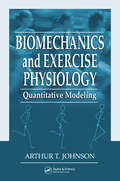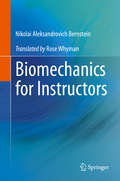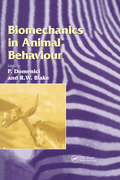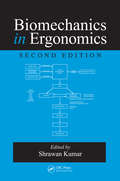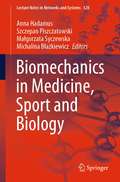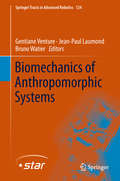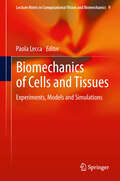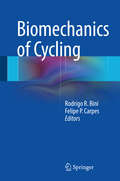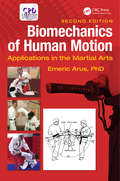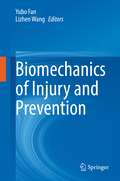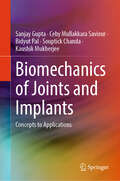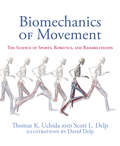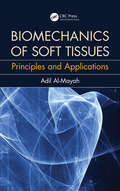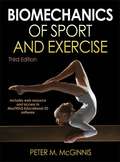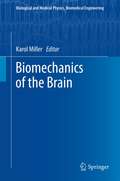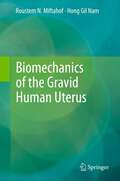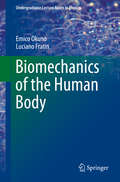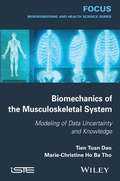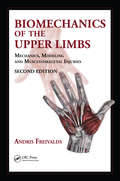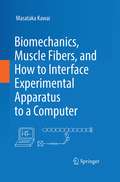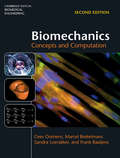- Table View
- List View
Biomechanics and Biomaterials in Orthopedics
by Dominique G. PoitoutWiththe constant evolution of implant technology, and improvement in the productionof allograft and bone substitutes, the armamentarium of the orthopaedic surgeonhas significantly expanded. In particular, the recent involvement ofnanotechnologies opens up the possibilities of new approaches in theinteractive interfaces of implants. With many important developments occurringsince the first edition of this well-received book, this updated resource informsorthopaedic practitioners on awide range of biomechanical advances in one completereference guide. Biomechanics and Biomaterials in Orthopedics,2nd edition compilesthe most prominent work in the discipline to offer newly-qualified orthopedicsurgeons a summary of the fundamental skills that they will need to apply intheir day-to-day work, while also updating the knowledge of experienced surgeons. This bookcovers both basic concepts concerning biomaterials and biomechanics as well astheir clinical application and the experience from everyday practical use. Thisbook will be of great value to specialists in orthopedics and traumatology,while also providing an important basis for graduate and postgraduate learning.
Biomechanics and Exercise Physiology: Quantitative Modeling
by Arthur T. JohnsonWhether you are a bioengineer designing prosthetics, an aerospace scientist involved in life support, a kinesiologist training athletes, or an occupational physician prescribing an exercise regimen, you need the latest edition of Biomechanics and Exercise Physiology: Quantitative Modeling. Using numerous worked examples to demonstrate what and when
Biomechanics for Instructors
by Nikolai Aleksandrovich BernsteinThis book comprises a series of lectures given by celebrated Soviet neurophysiologist Nikolai Alexandrovich Bernstein in Moscow in 1925 and first published in Russian in 1926. Bernstein’s groundbreaking work, which has had a significant influence on the development of neuroscience, movement studies, and other fields of study in Russia, Eastern Europe, and the West, was suppressed during Stalin’s regime. At the time of its publication, Biomechanics for Instructors was a significant resource for teachers, with its descriptions of the movement of joints and degrees of freedom, illustrations of how to calculate the work capacity of muscles with bones acting as levers, the role of the central nervous system in movement, and more. Though the terminologies and methods have changed and been updated as research and technologies have progressed, the book remains a valuable introduction for those interested in Bernstein’s work more generally, and to those involved in the study of biomechanics. This book is also of interest to historians and philosophers of neuroscience, as well as those involved in movement studies in both the scientific and artistic domains, and to physiotherapists and those involved in sports research and practice.
Biomechanics in Animal Behaviour
by P. DOMENICI; R.W. BLAKEBiomechanics in Animal Behaviour offers a unique approach by integrating fully the fields of animal behaviour and biomechanics. It demonstrates how an understanding of biomechanical issues is an important part of evaluating and predicting animal behaviour. The book examines how behaviour is determined and/or constrained by biomechanical variables such as hydrodynamics, aerodynamics, kinematics, and the mechanical properties of biomaterials.
Biomechanics in Ergonomics
by Shrawan KumarSafety or comfort? Can you truly have one without the other? Is it feasible to have both? Although by no means the only factor, a deep understanding of biomechanics plays a leading role in the design of work and workplaces that are both pain and injury free. Standing firmly on the foundation built by the previous edition, the second edition of Biom
Biomechanics in Medicine, Sport and Biology (Lecture Notes in Networks and Systems #328)
by Szczepan Piszczatowski Anna Hadamus Małgorzata Syczewska Michalina BłażkiewiczThis book contains fourteen chapters dealing with various aspects of the biomechanics of today. The topics covered are glimpses of what modern biomechanics can offer scientists, students, and the general public. We hope this book can be inspiring, helpful, and interesting for many readers who are not necessarily concerned with biomechanics daily.
Biomechanics of Anthropomorphic Systems (Springer Tracts in Advanced Robotics #124)
by Jean-Paul Laumond Gentiane Venture Bruno WatierMechanical laws of motion were applied very early for better understanding anthropomorphic action as suggested in advance by Newton «For from hence are easily deduced the forces of machines, which are compounded of wheels, pullies, levers, cords, and weights, ascending directly or obliquely, and other mechanical powers; as also the force of the tendons to move the bones of animals». In the 19th century E.J. Marey and E. Muybridge introduced chronophotography to scientifically investigate animal and human movements. They opened the field of motion analysis by being the first scientists to correlate ground reaction forces with kinetics.Despite of the apparent simplicity of a given skilled movement, the organization of the underlying neuro-musculo-skeletal system remains unknown. A reason is the redundancy of the motor system: a given action can be realized by different muscle and joint activity patterns, and the same underlying activity may give rise to several movements. After the pioneering work of N. Bernstein in the 60’s on the existence of motor synergies, numerous researchers «walking on the border» of their disciplines tend to discover laws and principles underlying the human motions and how the brain reduces the redundancy of the system. These synergies represent the fundamental building blocks composing complex movements.In robotics, researchers face the same redundancy and complexity challenges as the researchers in life sciences. This book gathers works of roboticists and researchers in biomechanics in order to promote an interdisciplinary research on anthropomorphic systems at large and on humanoid robotics in particular.
Biomechanics of Cells and Tissues: Experiments, Models and Simulations (Lecture Notes in Computational Vision and Biomechanics #9)
by Paola LeccaThe application of methodological approaches and mathematical formalisms proper to Physics and Engineering to investigate and describe biological processes and design biological structures has led to the development of many disciplines in the context of computational biology and biotechnology. The best known applicative domain is tissue engineering and its branches. Recent domains of interest are in the field of biophysics, e.g.: multiscale mechanics of biological membranes and films and filaments; multiscale mechanics of adhesion; biomolecular motors and force generation. Modern hypotheses, models, and tools are currently emerging and resulting from the convergence of the methods and phylosophycal apporaches of the different research areas and disciplines. All these emerging approaches share the purpose of disentangling the complexity of organisms, tissues, and cells and mimiking the function of living systems. The contributions presented in this book are current research highlights of six challenging and representative applicative domains of phyisical, engineering, and computational approaches in medicine and biology, i.e tissue engineering, modelling of molecular structures, cell mechanics and cell adhesión processes, cancer physics, and physico-chemical processes of metabolic interactions. Each chapter presents a compendium or a review of the original results achieved by authors in the last years. Furthermore, the book also wants to pinpoint the questions that are still open and that could propel the future research.
Biomechanics of Cycling
by Rodrigo R. Bini Felipe P. CarpesBicycles have been a common device to enhance physical fitness level in gyms and training centers along with solid use in competitive sport. For that reason, biomechanics of cycling has grown as a research field with many publications addressing different perspective of the interaction between the cyclist and his bicycle. The most common end point of research on biomechanics of cycling is optimization of performance and reduction of injury risk. One goal of this book is to meet the growing need for a comprehensive presentation of contemporary knowledge on biomechanics of cycling which will positively influence the activity of cycling in a global fashion. In order to accomplish this purpose, ten chapters are presented with focus on varying methods for biomechanical analysis of cycling motion. The introduction section provides an overview of the main methods for assessment of cycling motion, including motion analysis, pedal force measurements, muscle activation, anthropometry and joint kinetics. These methods are discussed in depth in individual chapters followed by chapters on characteristics of bicycles and potential perspectives to improve their configuration in order to improve performance of cyclists and reduce their overuse injury risk. Moreover, a preliminary method to train technique in cyclists is shown. A final chapter provides authors perspective on the upcoming technology that should be effective in helping training of cyclists
Biomechanics of Human Motion: Applications in the Martial Arts, Second Edition
by Emeric Arus, Ph.D.This book covers the general laws governing human biomechanics through an extensive review of martial arts techniques and references to fundamental theory. Using straightforward mathematics and physics, this work covers indepth the anatomical foundation of biomechanics and physiological foundation of human motion through specific and relevant martial arts applications. This book also covers the kinematics and kinetics of biomechanics via examples from martial arts and their comparison to different sports techniques. It is written to be used and referenced by biomechanical professionals and martial arts enthusiasts.
Biomechanics of Injury and Prevention
by Yubo Fan Lizhen WangThis book summarizes the recent advancements for biomechanics of injury and prevention in mechanism, application and developing frontiers. Biomechanics plays an important role in achieving safety, health, comfort, and a high quality of life by revealing injury mechanism and providing prevention methods. The book covers injury and prevention to the entire human body, from head to toe, including injury and prevention in sports, traffic, accident, clinic and so on. In addition, bionics prevention method inspired by woodpecker is also introduced. The book provides the reader with not only the mechanism of injury but also the advanced injury diagnosis, treatment, and prevention devices based on biomechanics.
Biomechanics of Joints and Implants: Concepts to Applications
by Sanjay Gupta Ceby Mullakkara Saviour Bidyut Pal Souptick Chanda Kaushik MukherjeeThis textbook serves as a comprehensive resource for readers interested in applying the principles of engineering mechanics to analyse the mechanical and structural functions of the musculoskeletal system. Over the past few decades, orthopaedic practice has strongly been influenced by the contributions from mechanical analysis and design. This book sequentially presents basic concepts and applications necessary for understanding a biomechanical system. The book is specially focussed on analysis and design of orthopaedic implants used to treat skeletal diseases and disorders. The book begins with an introduction to the anatomy, physiology, and movements of human body and its mechanical analogy, followed by chapters on basic biomechanics of various joints and spine. It elaborately discusses the gait analysis and measurement techniques and systematically presents the quantitative estimation of musculoskeletal forces (joint forces and moments, muscle forces) using the fundamental concepts of joint dynamics (kinematics and kinetics), with relevant solved examples and exercises to impart basic understanding and knowledge to the students. It also discusses the basic concepts of mechanics of deformable bodies relevant for bone tissue as well as implanted bone structure, common failure mechanisms of implanted bone structure and biomaterials used in orthopaedic implants, and the steps involved in finite element modelling and analysis of implant-bone structures. Other topics covered include various theories, mathematical formulations, the computational framework of bone remodelling and bone ingrowth, mechanobiology based mathematical models of tissue differentiation, and simulations on tissue ingrowth have been presented along with the outcomes of our research activities, which may help and inspire the students to pursue research in this field.
Biomechanics of Movement: The Science of Sports, Robotics, and Rehabilitation
by Thomas K. Uchida Scott L DelpAn engaging introduction to human and animal movement seen through the lens of mechanics.How do Olympic sprinters run so fast? Why do astronauts adopt a bounding gait on the moon? How do running shoes improve performance while preventing injuries? This engaging and generously illustrated book answers these questions by examining human and animal movement through the lens of mechanics. The authors present simple conceptual models to study walking and running and apply mechanical principles to a range of interesting examples. They explore the biology of how movement is produced, examining the structure of a muscle down to its microscopic force-generating motors. Drawing on their deep expertise, the authors describe how to create simulations that provide insight into muscle coordination during walking and running, suggest treatments to improve function following injury, and help design devices that enhance human performance.
Biomechanics of Soft Tissues: Principles and Applications
by Adil Al MayahThe emerging paradigm of incorporating images and biomechanical properties of soft tissues has proven to be an integral part of the advancement of several medical applications, including image guided radiotherapy and surgery, brachytherapy, and diagnostics. This expansion has resulted in a growing community of medical, science, and engineering professionals applying mechanical principles to address medical concerns. This book is tailored to cover a range of mechanical principles, properties, and applications of soft tissues that have previously been addressed in various journals and "anatomical site-specific" books. Biomechanics of Soft Tissues follows a different approach by offering a simplified overview of widely used mechanical models and measuring techniques of soft tissue parameters. This is followed by an investigation of different medical applications, including: biomechanical aspects of cancerous tumor progressions, radiotherapy treatment, and image guided ultrasound guided interventions. Written by leading scholars and professionals in the field, Biomechanics of Soft Tissues combines engineering and medical expertise, thereby producing an excellent source of information for professionals interested in the theoretical and technological advancements related to soft tissues. The book provides medical professionals with an insight on various modeling approaches, testing techniques, and mechanical characteristics that are frequently used by engineers. Conversely, the presented medical applications provide engineers with a glimpse of amazing medical practices and encourage them to expand their roles in the medical field. Provides a simplified overview of mechanics of soft tissues. Highlights different techniques to measure tissues properties for engineering and medical applications. Contains novel ideas to address roles of mechanics in disease progression and treatment. Presents innovative applications of biomechanics in medical procedures.
Biomechanics of Sport and Exercise
by Peter McginnisBy providing mechanics before functional anatomy, the book helps students understand forces and their effects before studying how body structures deal with forces. Students will learn to appreciate the consequences of external forces, how the body generates internal forces to maintain position, and how forces create movement in physical activities. Rather than presenting the principles as isolated and abstract, the text enables students to discover the principles of biomechanics for themselves through observation. By examining ordinary activities firsthand, students will develop meaningful explanations resulting in a deeper understanding of the underlying mechanical concepts. This practical approach combines striking visual elements with clear and concise language to encourage active learning and improved comprehension.
Biomechanics of the Brain (Biological and Medical Physics, Biomedical Engineering)
by Karol MillerBiomechanics of the Brain will present an introduction to brain anatomy for engineers and scientists. Experimental techniques such as brain imaging and brain tissue mechanical property measurement will be discussed, as well as computational methods for neuroimage analysis and modeling of brain deformations due to impacts and neurosurgical interventions. Brain trauma between the different sexes will be analyzed. Applications will include prevention and diagnosis of traumatic injuries, such as shaken baby syndrome, neurosurgical simulation and neurosurgical guidance, as well as brain structural disease modeling for diagnosis and prognosis. This book will be the first book on brain biomechanics. It will provide a comprehensive source of information on this important field for students, researchers, and medical professionals in the fields of computer-aided neurosurgery, head injury, and basic biomechanics.
Biomechanics of the Brain (Biological and Medical Physics, Biomedical Engineering)
by Karol MillerThis new edition presents an authoritative account of the current state of brain biomechanics research for engineers, scientists and medical professionals. Since the first edition in 2011, this topic has unquestionably entered into the mainstream of biomechanical research. The book brings together leading scientists in the diverse fields of anatomy, neuroimaging, image-guided neurosurgery, brain injury, solid and fluid mechanics, mathematical modelling and computer simulation to paint an inclusive picture of the rapidly evolving field.Covering topics from brain anatomy and imaging to sophisticated methods of modeling brain injury and neurosurgery (including the most recent applications of biomechanics to treat epilepsy), to the cutting edge methods in analyzing cerebrospinal fluid and blood flow, this book is the comprehensive reference in the field. Experienced researchers as well as students will find this book useful.
Biomechanics of the Gravid Human Uterus
by Roustem N. Miftahof Hong Gil NamThe complexity of human uterine function and regulation is one of the great wonders of nature and represents a daunting challenge to unravel. This book is dedicated to the biomechanical modeling of the gravid human uterus and gives an example of the application of the mechanics of solids and the theory of soft shells to explore medical problems of labor and delivery. After a brief overview of the anatomy, physiology and biomechanics of the uterus, the authors focus mainly on electromechanical wave processes, their origin, dynamics, and neuroendocrine and pharmacological modulations. In the last chapter applications, pitfalls and problems related to modeling and computer simulations of the pregnant uterus and pelvic floor structures are discussed. A collection of exercises is added at the end of each chapter to help readers with self-evaluation. The book serves as an invaluable source of information for researchers, instructors and advanced undergraduate and graduate students interested in systems biology, applied mathematics and biomedical engineering.
Biomechanics of the Human Body (Undergraduate Lecture Notes in Physics)
by Emico Okuno Luciano FratinBiomechanics of the Human Body teaches basic physics concepts using examples and problems based on the human body. The reader will also learn how the laws of mechanics may help to understand the conditions of the static and dynamic equilibrium of one of the marvels of nature: the human body. The mathematical language used in physics has always been pointed out as responsible for students' difficulties. So, each concept given is followed by explanatory examples, with subsequent application and fixation exercises. It is a richly illustrated book that facilitates the comprehension of presented concepts. Biomechanics of the Human Body can be useful to students of physical and occupational therapy, physical education, the life sciences, and health care professionals who deal with biomechanics. This book is also recommended for sport practitioners as well as the general reader interested in the mechanics of the human body.
Biomechanics of the Human Urinary Bladder
by Roustem N. Miftahof Hong Gil NamAs a research subject, the biomechanics of the urinary bladder are relatively young, yet medical problems associated with them are as old as mankind. Offering an update on recent achievements in the field, the authors highlight the underlying biological, chemical and physical processes of bladder function and present the systematic development of a mathematical model of the organ as a thin, soft biological shell. The book will be a valuable resource for postgraduate students and researchers interested in the applications of computational mathematics and solid mechanics to modern problems in biomedical engineering and medicine.
Biomechanics of the Musculoskeletal System: Modeling of Data Uncertainty and Knowledge
by Tien Tuan Dao Marie-Christine Ho ThoThe topic of this book is the modeling of data uncertainty and knowledge for a health engineering problem such as the biomechanics of the musculoskeletal system. This is the first book on this subject. It begins with the state of the art in related topics such as data uncertainty, knowledge modeling, and the biomechanics of the musculoskeletal system, followed by fundamental and theoretical aspects of this field. Clinically relevant applications of musculoskeletal system modeling are then introduced. The book finishes with a chapter on practical software and tools for knowledge modeling and reasoning purposes.
Biomechanics of the Upper Limbs: Mechanics, Modeling and Musculoskeletal Injuries, Second Edition
by Andris FreivaldsThere is already a wealth of literature covering cumulative trauma disorders and medical management, as well as the biomechanics of manual material handling and lower back problems. However, despite a spike in the number of work-related musculoskeletal disorders (WRMSDs) in the upper limbs-due to a sharp increase in the amount of computer-related j
Biomechanics, Muscle Fibers, and How to Interface Experimental Apparatus to a Computer
by Masataka KawaiThis book is written to help and enable students in how to observe biological specimens in terms of viscosity, mass, elasticity and work producing elements. The observations are related to underlying chemical reactions by means of strain (fractional length change) sensitivity of the reactions, and a theory is developed how to connect these. Their mathematical derivation is complex when three or more states are involved, but a method is presented here to demonstrate how to simplify this complex problem. Basic mathematical solutions that are useful for this book, are presented (Fourier and Laplace transforms, differential equations, matrix operations) together with Fortran programs in the Appendix.
Biomechanics: Concepts and Computation (Cambridge Texts in Biomedical Engineering)
by Cees Oomens Marcel Brekelmans Frank Baaijens Sandra LoerakkerThoroughly revised and updated for the second edition, this comprehensive textbook integrates basic and advanced concepts of mechanics with numerical methods and biomedical applications. Coverage is expanded to include a complete introduction to vector and tensor calculus, and new or fully updated chapters on biological materials and continuum mechanics, motion, deformation and rotation, and constitutive modelling of solids and fluids. Topics such as kinematics, equilibrium, and stresses and strains are also included, as well as the mechanical behaviour of fibres and the analysis of one-dimensional continuous elastic media. Numerical solution procedures based on the Finite Element Method are presented, with accompanying MATLAB-based software and dozens of new biomedical engineering examples and exercises allowing readers to practise and improve their skills. Solutions for instructors are also available online. This is the definitive guide for both undergraduate and graduate students taking courses in biomechanics.
Biomechanics: Optimization, Uncertainties and Reliability
by Abdelkhalak El Hami Ghias KharmandaIn this book, the authors present in detail several recent methodologies and algorithms that they developed during the last fifteen years. The deterministic methods account for uncertainties through empirical safety factors, which implies that the actual uncertainties in materials, geometry and loading are not truly considered. This problem becomes much more complicated when considering biomechanical applications where a number of uncertainties are encountered in the design of prosthesis systems. This book implements improved numerical strategies and algorithms that can be applied to biomechanical studies.

